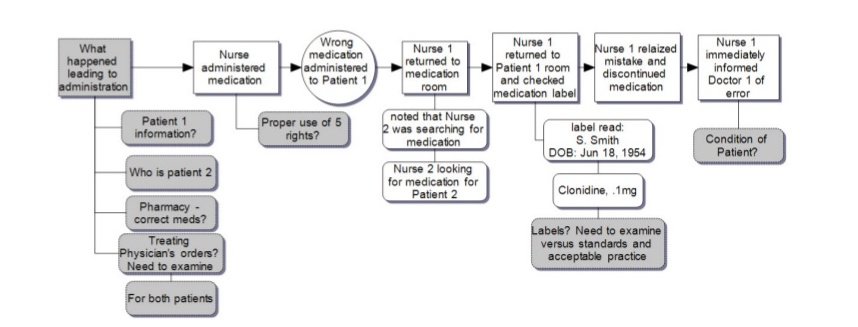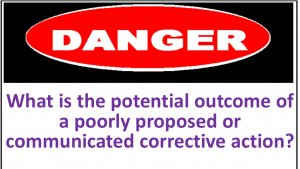What Is SMARTER & What Does It Have To Do With Your Investigation?

Our 5-Day TapRooT® Advanced Root Cause Analysis Team Leader Training encompasses essential tools and techniques required to successfully accomplish an investigation of an incident — SMARTER is one of them.
If you’re wondering what SMARTER is, read on. Prior to beginning your investigation, it’s imperative that you keep an open and curious mind, leaving all assumptions, biases, guesses, and preconceptions out of the process.
You’ll begin the TapRooT® Root Cause Analysis by planning to obtain the most accurate and thorough information essential to your incident investigation. Planning is followed up by the TapRooT® System of investigating and analyzing the incident to pinpoint Causal Factors and their root causes. In this phase, it’s crucial to remember that “You can’t solve all human performance problems with discipline, training, and procedures.”
By providing better root cause analysis and a key tool, the Corrective Action Helper® Guide, TapRooT® helps investigators develop better corrective actions and directs investigators to use ways beyond their experience to solve problems.
In a TapRooT® RCA investigation, a corrective action is a mistake or failure that, if corrected, could have prevented an incident or significantly mitigated its consequences. Based on the Corrective Action Helper® Guide, you can develop some simple SMARTER corrective actions.
What is SMARTER?
SMARTER is an acronym that spells out specific considerations for your corrective actions. You will consider each letter and an associated series of questions or statements when formulating your corrective actions.
Specific
Who will do exactly what by when? Are corrective actions specified in numbers? Is the action required specifically stated and unambiguous? Can those responsible for implementation tell what needs to be done without interpretation? Bad example: “Clean up the air.” Good example: “The shift supervisor will use high-efficiency filters to reduce particulate contamination of the exhaust to less than 0.01 ppm.”
Measurable
Can the corrective action be measured (quantitatively) to see when the corrective action implemented and to see if the corrective action actually fixed the root cause to prevent future problems? (Waiting for an infrequently occurring incident to reoccur is not a good measure of effectiveness.)
Accountable
Is the person responsible for implementing the corrective action clearly assigned? Do they have adequate authority and resources to accomplish the corrective action by the due date?
Reasonable
Is this corrective action practical? Is there a simpler or less expensive way to do the same thing? Can you convince management that there is a reasonable return on investment for this corrective action? Have you discussed the corrective action with those who will own it (those who have to implement it and live with it), and do they believe it is reasonable?
Timely
Is the due date for the corrective action soon enough, given the consequences of another failure? If the frequency of failure is high and the consequences of failure are significant, does the report offer interim action to reduce the risk while the final corrective actions are being implemented? Should the plant, equipment, or process be restarted or resumed before the corrective action, or at least the interim action, is implemented?
Effective
Will the corrective action prevent or significantly reduce the odds of this problem happening again?
Reviewed
Will this corrective action cause any problems? Has someone independent from the investigation team reviewed the corrective action for unintended negative impacts on the process or the people? Have you discussed the corrective action with those who will own it (those who have to implement it and live with it), and do they see any negative impacts that might outweigh the advantages?
TapRooT® developed a SMARTER matrix from the SMARTER acronym
The matrix helps guide the development of corrective action for each root cause of every Causal Factor. After a corrective action is developed, it should be reviewed by people independent of the development of the corrective action. This corresponds to the “R” step in the SMARTER acronym. The independent review should include those whose work will be impacted by the corrective action.
Creating SMARTER corrective actions provides guidance—or you can think of it as guardrails—during the process to ensure the best solution, or “fix.” It also helps prevent the incident from future occurrences.
There’s a SMARTER wizard to help you!
We have a guide in the step-by-step process of arriving at SMARTER corrective actions: the TapRooT® VI Software is equipped with a wizard, or a setup assistant, to lead you through the letters of the SMARTER acronym. This methodology helps you consider all critical aspects that culminate in creating the most effective corrective actions.
When you have completed each step in the SMARTER wizard, the Implementation, Verification, and Validation Plans with corresponding Due Dates and Persons Responsible will automatically add as Tasks to your corrective actions. You will be able to track what is completed or lacking or past the Due Date.
In case you don’t require a SMARTER corrective action with multiple tasks, TapRooT® VI equips you with the option to document a simple version of a corrective action: A toggle button allows you to choose between creating the SMARTER or SIMPLE corrective action, depending on your needs.
How often do you review your corrective actions for unintended consequences?
If you see “bugs” in your corrective action board, think about attending one of our TapRooT® Root Cause Analysis System courses, training that helps solve problems both reactively and proactively. We can show a proven SMARTER process before a corrective action becomes another incident.
Register today for a TapRooT® Root Cause Analysis Training Course
TapRooT® training is global to meet your needs. If you need particular times or locations, please see our full selection of courses.
If you would like us to teach a course at your workplace, please reach out to discuss what we can do for you, or call us at 865.539.2139.
By the way, you heard Alex and Benna mention “The Summit,” right? The next Global TapRooT® Summit is at Margaritaville Lake Resort, Lake Conroe – Houston, Texas, on April 24 – 28, 2023.
Image source/credit: Photo by krakenimages on Unsplash.




